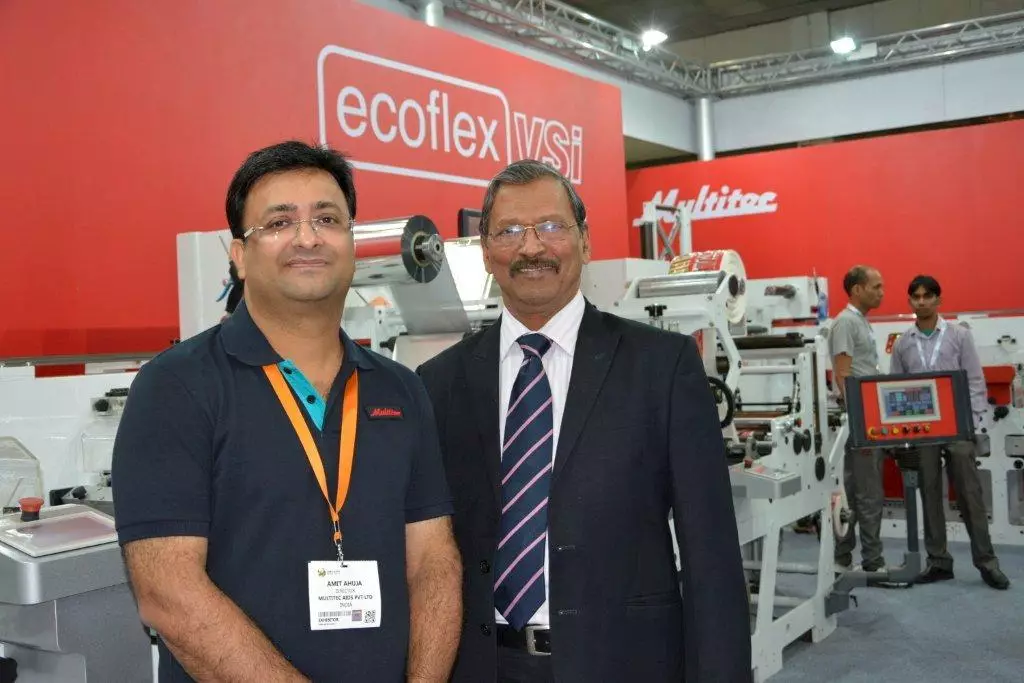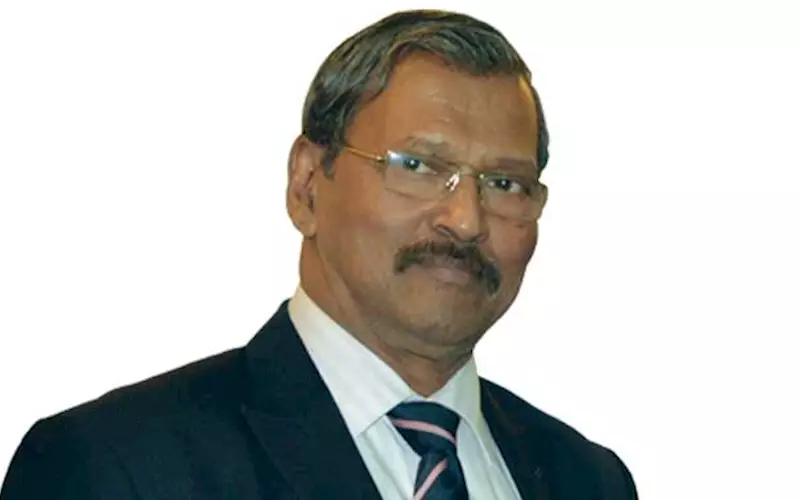Sudhir Samant’s label talk - The Noel D'Cunha Sunday Column
The former Reifenhauser India executive, Sudhir Samant announced his retirement in July 2013 after serving the print industry for 40 years, much of it in the label and packaging segment. He made a comeback as a consultant a little later, and has been a sought after man, since then.
Samant says, “It’s a different market today. There are new wider machines, and new things being produced on them.” But Samant feels the industry needs to see the capability and the compatibility from the othe
21 Oct 2016 | By Noel D'Cunha
PrintWeek India (PWI): Multigraph is the authorised representative of Manugraph. What is your role here?
Sudhir Samant (SS): I am a consultant for packaging development, but advice mainly on products related to narrow-web. Multigraph represents international companies like Zonten, Kunrun, and C&C Flexo. It is also an authorised representative for Indian manufacturers Kohli and Multitec. As for Multitec, the company only handles the Middle East and African markets, not the Indian market.
PWI: Any installations by Multigraph?
SS: The company has sold its first Multitec since the tie-up, to a customer in Kenya. The customer was recently in India for pre-shipment trial. The machine is expected to be installed early December 2016.
PWI: You’ve been associated with the Indian print industry for the last 40 years, a lot many years of which has been in the labels and packaging segment. What are some of the new things that you are seeing today?
SS: The new thing which has come now is the LED in India. We saw the technology at Labelexpo Europe in 2015, and though in terms of sales it is very low, I see that it will grow in time to come.
PWI: But LED ink is expensive, and it also jacks up the cost of the press that runs that kind of ink?
SS: The LED inks are presently expensive, but it’s going to be the future on mainly two fronts – the cost of the lamps as well as the savings on power consumption including lower A/C utilization.
PWI: How is that?
SS: In the narrow-web, there are two major UV system suppliers, one is GEW and second IST. From what I understand, GEW has a major market share in India.
The life of UV lamps is around 1,200 to 1,500 hours. This means you have to change the mercury lamps on your press every 1,200-odd working hours. Now the cost of the lamp is around Rs 15,000 to Rs 18,000, and this depends on the width of the lamp. So if you consider an eight-colour press, running eight hours in two shifts, you will have to change the lamps every six to eight months, depending on the number of days you run the press.
Whereas life of LED lamps is approximately 25,000 to 30,000 hours, and though it is a little bit expensive, you won’t need to change them for the next six to eight years. Secondly, the heat UV lamp generates requires a powerful air-conditioner to control the press-room temperature. But the LED system drastically cuts down the utilisation of air-conditioner.
Yes, the ink cost is around 40% higher than the UV inks, but once printers start adopting the LED system, it will lead to increase in the volume of ink used and decrease the cost of ink.

PWI: So when do you see this happening?
SS: It is a continuous process. Like it happens with other products, once the manufacturers recover their R&D cost, the product is generally made available at competitive price.
PWI: What are the other trends that you are seeing?
SS: In-mold is growing again. There are two areas in in-mold, one is injection molding and other is blow molding. It is a label but in a different form. It is a replacement to self-adhesive and has the ability to enhance brand protection. It is environment-friendly, as you can recycle the label with the container itself.
PWI: During this edition of PrintWeek Awards, we had a range of exciting label samples. So lots of new things are coming up…
SS: Yes, labels have become special. For example, brands now want to pack the information – one in the form of production information, and other is the statutory information. All this in a small label. So in order to accommodate the information you need to come up with new applications like coupon labels, labels on label and booklets among many others.
PWI: True, the label press manufacturers too are trying out new things, like wide-width, making the printing cylinders lighter for easy handling…
SS: It’s a different market today, and it’s not just for labels. Everyone is launching wider machines, new things on them. There is a shift happening which I am seeing in the last 15 years in the label industry. But the manufacturer or the industry too needs to see the capability and the compatibility on the other side. You have the capability but can you compete?
In early 2000, at the Labelexpo, most of the exhibitors were showing label presses running paperboard. But before the next Labelexpo, the offset sheetfed manufacturers too came up with a flexo as their first unit, which allowed them to print white or metallic colour for METpet application. You can print 1,000 to a million copies by sheetfed offset, whereas flexo is not economical for short-run carton converting.
PWI: Flexo Vs gravure?
SS: Today, lots of labels are being printed on films – including monofilms which can be shrink sleeve or in-mold. If the quantity is less than 50,000 then you cannot do it using the gravure, because the cost of the gravure cylinder is around Rs 8,000 per colour, which would mean Rs 40,000 for four colours plus another Rs 8,000 if there is a white to be printed. But if you do it on the narrow-web flexo, then you can process the flexo plates at a fractional cost compared to gravure cylinder. For the gravure, your wait for cylinder would be around week while in the flexo it would be delivered either on the same or next.
Further, new brands which are not multi-nationals, but local, have limited quantities of their products. Take for instance juices with seven to eight flavors. Here the quantity of each may not warrant large volumes for each of the flavor. Printing a quantity of 40,000-50,000 shrink sleeves on gravure will not be affordable primarily because of the cost of cylinders and other inputs. Flexo will be the most ideal because you will get the desired quality at a reasonable price.
PWI: In terms of relevancy in India, is it flexo or gravure?
SS: I can’t say, but what I can say is that flexo is more relevant for Europe because every country has a different language, and the information on the labels is specific to that country. Hence the requirement is small- to medium-run length.
In India, the marketing language for Coke, Pepsi or Unilever from North to South, and East to West, is English. This means the wrapper or shrink sleeves are produced in greater numbers. For flexo to grow, the information now printed in English will have to be printed in local language, which will bring down the volume, but will increase the SKUs.
That’s why printing on film is done on the one meter or 1.3 meters wide gravure presses because of the volumes. When you print on the film, you do not require any post-printing converting like labels. The films are printed and slit. You just need an offline slitter to make smaller rolls for either the shrink sleeves or wraparounds.
PWI: What is the run that you think will be ideal for a wider width flexo?
SS: If the run length is one-lakh and above then it will work. It is like a crossline when you compare digital versus offset, a quantity of 20,000+ become affordable on an offset, while anything less than 2,000 can be produced using digital. It’s a similar case here.
PWI: You spoke about information getting regional and local. Don’t you see a role for digital here?
SS: I don’t think there’s place for digital printing in a production environment right now. I see digital in pre-marketing activities, where you want, for example, 100 bottles for a campaign. But for 50,000 bottles, flexo will be the option. I am talking from an Indian point of view.
Further in India, there are not more than 10 to 12 digital operating label presses. Digital printing unlike flexo, has its share of limitation, where certain processes have to be done offline.
PWI: Recently, we saw two Iwasaki intermittent offset presses installed at Sel Jegat and Wintek – combination presses…
SS: Same again, it’s about the capability and compatibility. It’s also about the overall cost of production. Flexo plate costs around Rs 1.5 per sq/cm. And that is much costlier than the offset CTP plate.
On the other hand offset presses are much costlier than flexo, hence you can’t have the luxury of ten-colour units. So, you have four or five units of offset, two of flexo to put white or metallic or varnish, then it becomes a combination press.
PWI: For somebody who has been in the flexo industry for long, do you expect a return of offset or letterpress in some way?
SS: Till 2000, the label industry was dominated by letterpress. It was all Japanese brands which the people were using in India. Around 1995 onwards the flexo presses started coming into the country and slowly the letterpress started declining. Today, the letterpresses are coming into the country exclusively for the lamitube industry, and I am talking about the CI letterpresses. Now the transition is happening, and you will see intermittent offset taking some market share.
PWI: Rs 3,000-cr industry with 500+ presses and less than 400 players. Is it too small or too many?
SS: For a country like the UK, which has a population of 60-mn, there are 300 label printers and Japan has 2,200. I think the number would correlate with the amount of labels we consume. If you look at the per capita label consumed, and I am not talking about other label material, like in-molds, shrink sleeves and wrap around, is around 0.8 to 0.9 sq/mtr whereas in the European countries and the USA it is 8 to 12 sq/mtr.
PWI: Self-adhesive versus wet-glue?
SS: It’s wet-glue. In India lot of smaller brands are still using wet-glue labels, particularly in the tier-2 and tier-3 cities. One, they don’t have someone to deliver labels in the self-adhesive form. Second, the liner used in the self-adhesive labels is a waste, making the self-adhesive labels three to four times costlier than the wet-glue labels.
PWI: There are other ways of printing labels on the product…
SS: Labels have become multifarious. There are other ways of printing labels, besides self-adhesive and wet-clue – through heat transfer, direct and pad printing among others. The buyer is going to look at three things – quality, delivery time and cost. The quality depends on what segment you are in. Any technology that can offer these three criteria will gain prime importance.
PWI: Manugraph mulling manufacturing CI flexo presses?
SS: Manugraph has a manufacturing plant Kolhapur, which is world class and they have one in the US as well. Talking about CI flexo, no one is that good in Asia for making a CI flexo. Today, majority brand manufacturers are from Europe.
So, if the Italian machines are manufactured in India at 70% of the cost, would it not be viable, both for local as well as international markets?











 See All
See All